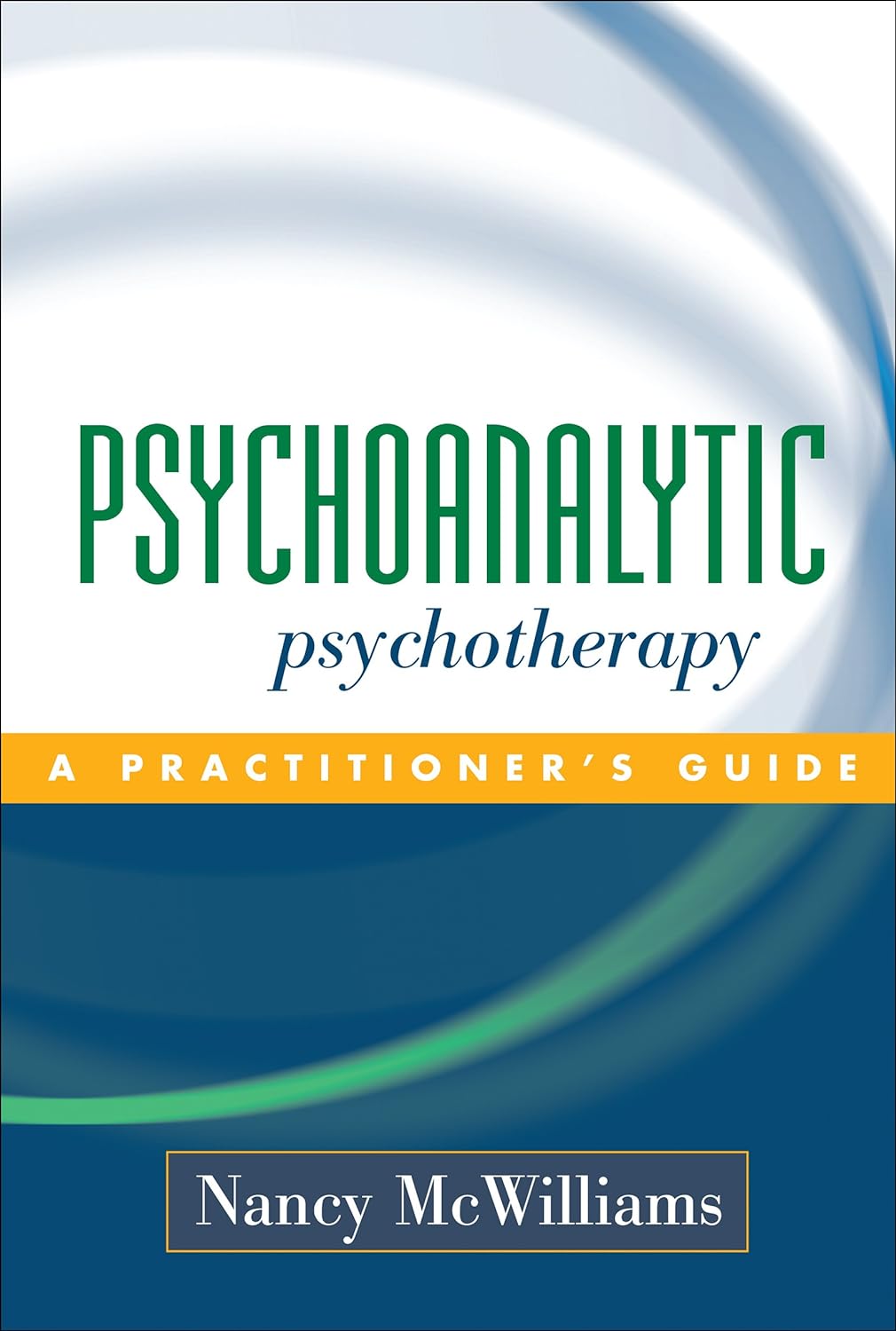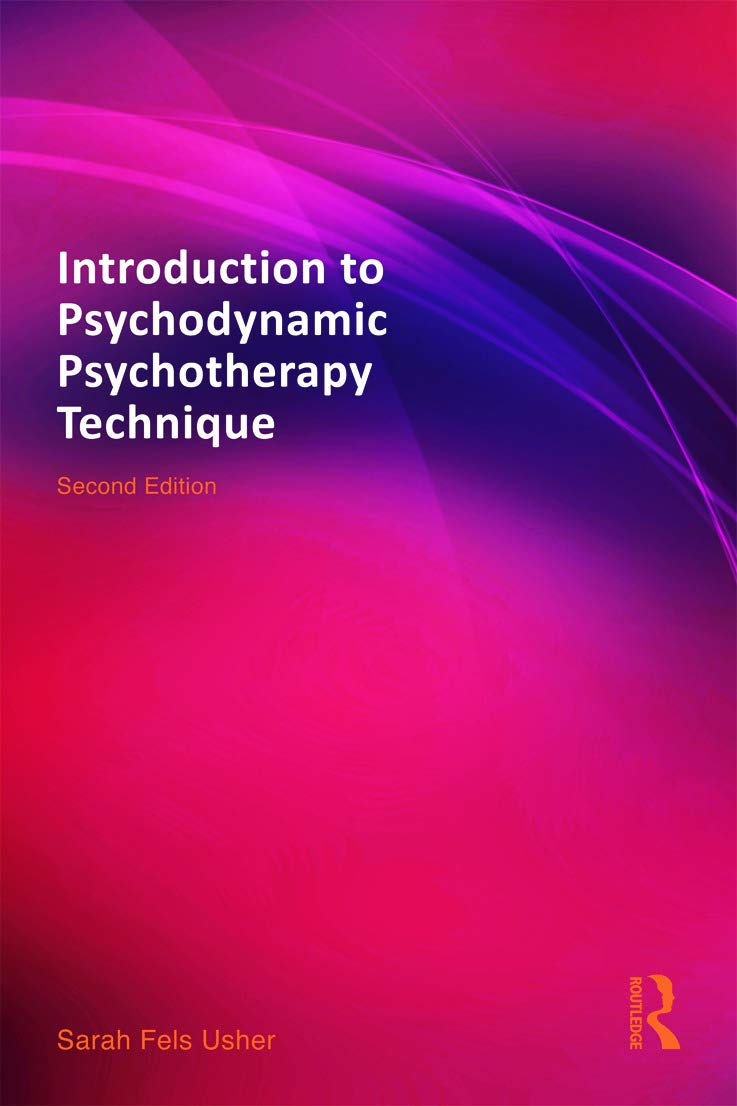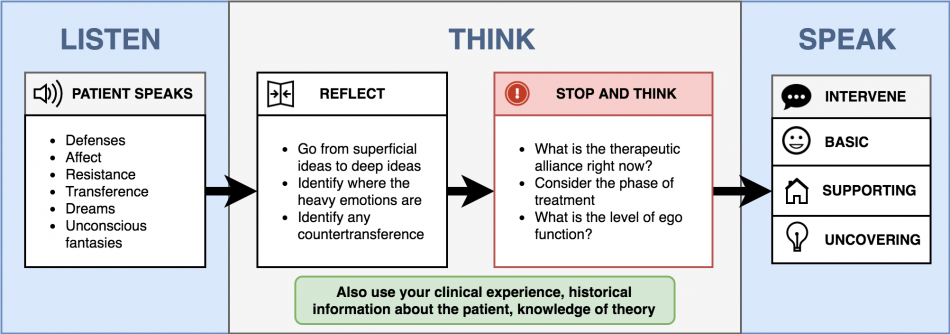- Last edited on January 27, 2024
Psychodynamic Psychotherapy
Primer
Psychodynamic Psychotherapy is a psychotherapy that focuses on the role of unconscious conflict that can cause a patient to experience symptoms (e.g. - depression and anxiety). It emphasizes ways in which past experiences shape present situations. Psychodynamic psychotherapy involves the exploration of transference (feelings that the patient has toward another person which they unconsciously redirect toward the therapist) to explore unresolved issues. It is typically used in higher-functioning patients (e.g. - patients are not actively suicidal, have no serious substance-abuse problems, and have no acute instability in their lives).
Indications
Psychodynamic psychotherapy is indicated when a patient's problems are linked to unconscious factors that lead to interpersonal difficulties, maladaptive ways of coping with stress, and/or distorted self-perceptions. Generally speaking, individuals with depression, anxiety, certain personality disorders, or trauma may be suitable for psychodynamic therapy.
Psychoanalysis vs. Psychodynamic
Psychoanalytic theory and psychoanalysis refers to the original perspective and theoretical ideas proposed by Sigmund Freud. Psychodynamic theory and psychodynamic therapy refers to the later ideas and perspectives that originated from Sigmund Freud and his followers since then. These two terms are often used interchangeably.How Does it Work?
There are several theories as to why psychodynamic therapy is efficacious as a treatment modality, including:
- Making the unconscious conscious: that unconscious thoughts and feelings affect and motivate people, and becoming aware of these thoughts is therapeutic. It allows the patient to better know themselves, and releasing these unconscious ideas can be cathartic
- Supporting weakened ego function: psychodynamic therapy helps patient by supporting their ego function (you will learn more about this in the sections below)
- Reactivating mental and emotional development: psychodynamic therapy can reactivate a patient's mental and emotional development, which leads to new and healthier growth. Examples include developing new ways of thinking about themselves, relating to others, and developing more adaptable and flexible coping skills/mechanisms
Efficacy
Psychodynamic therapy is effective and has modest to large effect sizes for common mental disorders, including anxiety and depressive disorders.[1][2] Psychodynamic therapy should not be limited to adults, and can be used in children (e.g. - play therapy) and adolescents as well.[3][4]
The Mind
In psychodynamic psychotherapy, the human mind can be thought of as three parts: the id, the ego, and the superego. Unlike contemporary neuroscience, these are not anatomical regions of the brain, but rather a conceptual idea.
The Mind: Id, Ego, Superego
| Id | Wishes and desires |
|---|---|
| Ego | Manages inner mental life and relationship to the outer environment (the world) |
| Super-Ego | Conscience and personal ideals |
Ego Functions
Since the ego mediates between the desires of the id and the super-ego, it needs tools to do this mediation. These tools are called ego functions, and helps an individual modulate their responses to both internal and external stimuli. Some ego functions protect us from external environment stimuli, while other ego functions protect us from inner stimuli. Ego functions include:
- Reality testing and sense of reality
- Judgment
- Relationships with others
- Sensory stimulus regulation
- Affect/anxiety tolerance
- Impulse control
- Capacity for play
- Self-awareness and psychological-mindedness (are patients open to the idea of unconscious thoughts affecting their behaviour?)
- Self-esteem regulation/accurate self-appraisal
- Cognitive functions
Not everyone has strong ego functions (i.e. - some people have weak ego function or “weak tools”). They may have poor tolerance, poor relationship with others, and/or difficulty with reality testing. Part of psychotherapy is helping you strengthen these functions. Individuals with strong ego functions are said to have good ego strength.
Defenses
Defense mechanisms are an important part psychodynamic therapy. Defenses are thoughts and behaviors (both voluntary or involuntary) that an individual uses to resolve conflict and prevent undesirable feelings (e.g. - depression). Learning to identify and understand defenses is important in psychodynamic psychotherapy.
Structure
Selecting a Patient
For a beginner, a psychotherapy patient should:[5]
- Not be actively using substances
- No active suicidal or homicidal ideation
- No psychotic symptoms
- Be psychologically-minded
- Be of at least average intellect
- The patient should be interested in treatment
- Is able to form close relationships
- Some degree of awareness of their emotions and how it affects them
- The patient is able to tolerate ambiguity and lack of structure
The First Session
The first few sessions of psychotherapy typically focus on understanding and taking a good relationship history, from childhood up to adulthood. Here are some key topics that need to be addressed during the first session:
- Explore why the patient is interested in therapy at this time
- Have a discussion about their childhood
- A detailed relationship history, involving parents, siblings, friends, and romantic relationships
- What was useful about their previous therapy sessions
- What symptoms are they hoping will be addressed through therapy?
- What symptoms are affecting them now?
- A review of substance use and safety
Educate Your Patient on Psychodynamic Therapy!
It can be helpful to first ask your patient what they think psychotherapy is. The following educational pieces might also be helpful for your patient to know:- Every session is different
- Important to attend each session
- Non-judgmental space, confidential space, to help you understand yourself
- Can really talk about whatever, this full hour is your time
- It’s okay to be off-topic, the idea is “free association”
- You should walk out of a session emboldened, and feel better
- Even if you think there’s nothing to talk about, there’s something to talk about
- Sometimes might have things to say about this relationship (the therapist-patient relationship), and that’s okay!
- Let me know if you feel like things are helping, or things are not working and you would like to see it changed
- Psychodynamic therapy can take many years
- “You can’t leave somewhere you haven’t arrived at yet”
The Second Session
At a certain point, you will have collected enough social history, and it is time to transition and let your patient know that the therapy will become much less structured. For example, to start this session, you can tell them “I'd like you to talk about whatever comes to your mind, and I will stop taking notes.” It is usually better to not take notes, so your patients are able to freely associate, and reduce biasing your patients in talking about what they think you want to hear.
What Do I Say? What Do I Not Say?
Psychodynamic therapy can be challenging for the novice practitioner due to the lack of structure, and the requirement of having the patient lead the session. Here are some tips to guide you:- If a patient asks: “Should I be feeling this way?” or “Is it normal to feel this way?,” you can validate and say “There are no shoulds or shouldn'ts with feelings. They just are. Feelings make sense.” The same would go for questions like: “Am I over-reacting?” You should tell your patients to show some compassion to themselves for having anger.
- When there is a deafening silence during a session, it's okay to say something like “talk about what feels important to you”
- If a patient is very self-critical about a situation or themsleves, it maybe appropriate to probe further and ask: “you seem to be very self-critical about [situation], why?”
Visualizing Psychotherapy
The following diagram (figure 1) helps illustrate some of the principles described here to visualize just how a psychotherapy session might work:
The Four Phases
Every psychodynamic therapy relationship with a patient has 4 phases:
Four basic phases of psychotherapy
| Evaluation | The initial assessment and history-taking phase |
|---|---|
| Induction | Beginning the treatment, developing therapeutic relationship, setting goals, helping patient learn to use therapy |
| Mid-phase | Majority of treatment time is spent here: the therapist and patient work together to achieve the therapeutic goals set during the induction phase |
| Termination | Ending of the treatment: goals are consolidated, treatment is reviewed, the change that has occurred is appraised and role of future change is also evaluated, planning for future therapy, and termination of relationship |
Tips and Techniques
Psychodynamic therapy is by definition very unstructured, but there are certain techniques that are frequently employed,[6] the main ones are:
1. Listening: Hear Your Patient
You listen to the content of their speech for particular themes, conflicts, and of course, their concerns. Listen for slips, also known as pararaxes, affects, free associations, transference, defences, unconscious fantasies, and dreams.
2. Reflecting: Process What They Say
After you have heard you patient, you need to process this information and understand its meaning. By understanding, you can decide you to respond and intervene. This process is called reflecting. First, let's go back to key idea of psychodynamic therapy: unconscious ideas affect conscious thoughts. Using this principle, this means you need to reach the unconscious thoughts first. This is why listening is so key: you listen for clues on the surface, to guide you to deeper towards unconscious thoughts.
All the material that patients give us is helpful in doing that. When reflecting, it is important to attend to three ideas: going from the superficial ideas to deep, identifying which topics contain the most affect (emotion) for the patient, and acknolwedging your counter-transferance (what feelings do you, as the therapist, have towards you patient? – are you reacting strongly to something a patient said because of your own biases/idiosyncrasies?)
3. Intervening: Respond to What They Say
How do you know what to say or if the patient is ready for it? There are 3 principles you can use:
- What is the therapeutic alliance? Therapeutic alliance is the amount of trust between a patient and a therapist. Alliance builds over time as therapists show their patients that they understand them. A strong therapeutic alliance allows a therapist to say things that might otherwise be quite painful to a patient had they heard it from the therapist the first time they met.
- What is the phase of the treatment? There are 3 phases to psychodynamic therapy: the beginning, the mid-phase, and the termination phase. The further a long a patient is in therapy, the easier it is for the therapist to make certain comments or observations
- And what is the patient's ego function? Is it important to constantly reassess your patient's ego function, as it will change and fluctuate depending on whether they are regressing, under stress, or medically ill.
Concepts
Pathological Accommodation
Pathological accommodation refers to ways of being that function unconsciously to preserve a needed attachment when that bond has been traumatically threatened. In this sense of the word, “accommodation” means that the individual unconsciously adopts the views and feelings of another at the expense of his or her own experience.[7]


